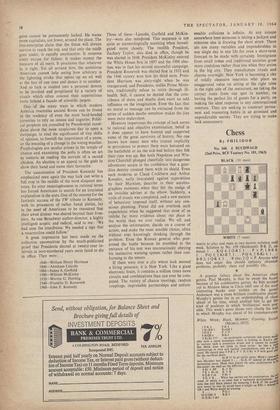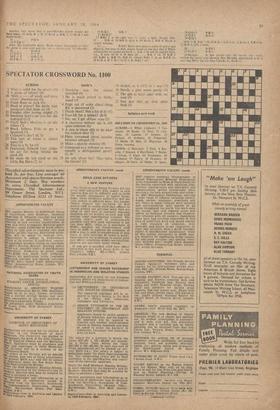Chess •
By PHILIDOR No. 160. J. BUCHWALD (2nd Prize, BCF Tourney No. 101, 1963) BLACK (10 men)
WHITE (7 men) wierre to play and mate in two moves; solution next week. Solution to No. 159 (Shinkman): B-K 2! no
threat 1 K-Q 4; 2 Q-B 5. 1 P x P; 2 B-13 4.
1 . . . P-Q 3; 2 Kt-B 7. 1 . P-Q 4; 2 B-Kt 4. 1 B-B 2; 2 Q-K 4. 1 ...B else; 2 Q X P. Anyone who does not enjoy this should certainly abandon problems, probably chess and possibly life.
A popular fallacy about the American chess genius, Paul Morphy, is that he swept the board because of his combinative genius. As Reti pointed out in Modern Ideas in Chess (still one of the most interesting books ever written on the game) Andersson was a more brilliant combinative player; Morphy's genius lay in an understanding of chess ahead of his time, which enabled him to get the kind of positions in which 'brilliancies' were pos- sible. This week's game shows very clearly the waY in which Morphy was ahead of his contemporaries.
White, MEEK; Black, MORPHY; Opening, Scotch P-K 4 P-K (MOBILE, 1855).
2 Kt-KB 3 Kt-QB 3 3 P 4 P X P
4 B--Q08 4 B-B 4 5 Kt-Kt 57? . .. no moderately competent club player wotaa play such a move nowadays—there is nothing in Black's pit to warrant such a premature attack and it cannot be correct. But Meek does not think in these terms: he has a litd..! combination in view and tactical considerations only are in mind. He should play 5 P-B 3. P X P; 6 Kt x P with good Or for the sacrificed pawn.
5 . ' Kt-R 3! In an earlier game: Meek's opponc, (not Morphy) had played 5 . . . Kt-K 4? instead of MorpIC developing move. Meek then played the same combination as "' this game—we shall see the difference. 6 Kt X BP K x Kt 7 B X Kt ch KX B 8 Q-R 5 ch P-Kt 3
9 Q X B... White has carried out his combination, the '1,14 result of which is to leave him a backward development:, t7"... note that had Black played the tempting 5 Kt-K 4? the positiTi now would be that he would have a knight on KKt I instead QB 3 and White would be winning.
9 P-Q 3 10 Q-QKt 5 R-K I II Q-Kt 3 eh?
Another had move that a post-Morphy player would not Lave made. 11 0-0, R x P. 12 Kt-Q 2, R-K 1; 13 Kt-13 3 was much better.
11... P-Q 4 12 P-KB 3?
After this deplorable move, Black makes mincemeat of him; the game is now over and the re,t play far Slorphy.
12... Kt-R4 13 Q Q P X P Q-R 5 eh 15 P-Kt 3 R x P .31 17 Kt-Q 2? 17 B-Kt 5 is the only way to make is fight, though after 17 . . . c)-}c 4; 18 B-B 4, Q-Q 4; 19 Kt-Q 2, B-B 4! Black is clearly winning.
17 R-K6! Black now plays a series of pretty and effective, but easy to find, moves based on the fact that if White relinquishes his guard on his K 2. K-K 7 ch will be rapidly fatal, e.g.. it now 18 Q X P then Hi. , R-K 7 ch; 19 K-B 3 (19 K-Kt 1, B-R 6), Bell 6! (threat 13.14t 7 ch or K-KB
20 Kt-K 4, R X Kt!; 21 Q X R, 13-Kt 7 ch! 18 Q-Kt 5 P-B 31 19 Q-I1 1 B-R 20 Q-Q 1 20 Q X.13, R-K 7 ch; 21 K-13 3, Q-K e Lb, 22 K•t: 4, P-R 4 ch: 13 K-It. 4, Q-K 2 mate.
20 ... 11-KB 1 21 Kt-13 3 K-K I 22 Resigns. A line attack—but the moves that really
settled the game and showed that Morphy understood it in a way that Meek did not were 5 Kt-Kt 5?, Kt-R 3)



































 Previous page
Previous page